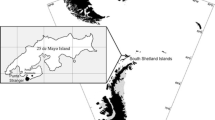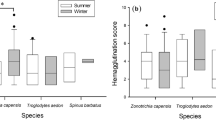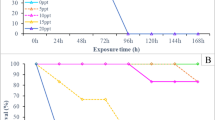Abstract
The capacity of seabirds to shape their physiological and immune phenotypes may often be constrained by the ecological context. While phenotypic plasticity in physiological traits has been previously studied, the molecular mechanisms underlying phenotype plasticity in response to environmental stress have been little explored. This prompted us to enquire about how the nutritional and immune status are involved in physiological adaptations in breeding seabirds under anthropogenic pressure. At Esperanza (Hope) Bay, Antarctic Peninsula exists one of the biggest breeding penguin colony of Pygoscelis adeliae (Adélie). At this location, penguins nest nearby the Argentinian Esperanza Station and, therefore, are exposed to high levels of disturbance, whereas there is a low disturbed area, where penguins also breed far away from the Station. In both areas, the nutritional and immune status in breeding individuals was addressed and serum protein expression level was analyzed using a proteomic approach. Body mass, proteins, albumin, and triacylglycerol were higher in penguins from the low disturbance area, whereas uric acid increased in individuals from the disturbed area, indicating a poorer body condition of penguins under anthropogenic pressure. Immune responses were elevated in penguins from the disturbed area (IgY, γ-globulins and hemagglutinating activity). Finally, individuals breeding under anthropogenic pressure overexpressed proteins with immune, antioxidant, and metabolic functions. The poor nutritional status of penguins under disturbance may be the consequence of the reallocation of resources to the immune system. Altogether, this would constitute a potential strategy to preserve an adequate immune phenotype under stressed environments.






Similar content being viewed by others
References
Acero JM, Agraz JL, Aguirre CA (1996) Revisión ambiental de las actividades antárticas en Bahía Esperanza. Instituto Antártico Argentino, pp 1–35
Ageitos JM, Sánchez-Pérez A, Calo-Matac P, Villa TG (2017) Antimicrobial peptides (AMPs): Ancient compounds that represent novel weapons in the fight against bacteria. Biochem Pharmacol 133:117–138
Barbosa A, Palacios MJ (2009) Health of Antarctic birds: a review of their parasites, pathogens and diseases. Polar Biol 32:1095–1115
Barbosa A, Merino S, Benzal J, Martinez J, García-Fraile S (2007) Geographic variation in the immunoglobulin levels in pygoscelid penguins. Polar Biol 30:219–225
Barbosa A et al (2013) Pollution and physiological variability in gentoo penguins at two rookeries with different levels of human visitation. Ant Sci 25(2):329–338
Bender NA, Crosbie K, Lynch HJ (2016) Patterns of tourism in the Antarctic Peninsula region: a 20-year analysis. Antarct Sci 28(3):194–203
Bertile F, Schaeffer C, Le Maho Y, Raclot T, Van Dorsselaer A (2009) A proteomic approach to identify differentially expressed plasma proteins between the fed and prolonged fasted states. Proteomics 9:148–158
Bertile F, Fouillen L, Wasselin T, Maes P, Le Maho Y, Van Dorsselaer A, Raclot T (2016) The safety limits of an extended fast: lessons from a non-model organism. Sci Rep 6:39008
BirdLife International (2018) State of the world’s birds: taking the pulse of the planet. BirdLife International
Blévin P, Tartu S, Angelier F, Leclaire S, Bustnes JO, Moe B, Herzke D, Gabrielsen GW, Chastel O (2014) Integument colouration in relation to persistent organic pollutants and body condition in arctic breeding black-legged kittiwakes (Rissa tridactyla). Sci Total Environ 1(470–471):248–254
Bonnedahl J, Broman T, Waldenstrom J, Palmgren H, Niskanen T, Olsen B (2005) In search of human-associated bacterial pathogens in Antarctic wildlife: report from six penguin colonies regularly visited by tourists. Ambio 34:430–432
Brock PM, Hall AJ, Goodman SJ, Cruz M, Acevedo-Whitehouse K (2013) Immune activity, body condition and human-associated environmental impacts in a wild marine mammal. PLoS ONE 8(6):e67132
Brommer JE (2004) Immunocompetence and its costsduring development: an experimental study in blue tit nest-lings. Proc R Soc Lond B 271:S110–S113
Burger J, Gochfeld M (2004) Marine birds as sentinels of environmental pollution. EcoHealth 1:263–274
Bustnes JO, Fauchald P, Tveraa T, Helberg M, Skaare JU (2008) The potential impact of environmental variation on the concentrations and ecological effects of pollutants in a marine avian top predator. Environ Int 34(2):193–201
Carlini AR, Coria RN, Santos MM, Libertelli MM, Donini G (2007) Breeding success and population trends in Adélie penguins in areas with low and high levels of human disturbance. Polar Biol 30:917–924
Cebuhar JD, Di Fonzo CI, Dopchiz LP, Ansaldo M (2017) Anthropogenic impact modifies the blood antioxidant status in Pygoscelis adeliae and Pygoscelis papua at Hope Bay Antarctic Peninsula. Ecotoxicol Latin Am 4:105–118
Cherel Y, Robin JP, Walch O, Karmann H, Netchitailo P, Le Maho Y (1988) Fasting in the king penguin i: hormonal and metabolic changes during breeding. Am J Physiol 254:R170–R177
Cockrem JF (2007) Stress, corticosterone responses and avian personalities. J Ornithol 148:S169–S178
Colominas-Ciuró R, Santos M, Coria M, Barbosa A (2017) Reproductive effort affects oxidative status and stress in an Antarctic penguin species: an experimental study. PLoS ONE 12(5):e0177124
Core Team R (2015) R: A language and environment for statistical computing. R foundation for statistical computing, Viena, Autria. URL: http://www.R-project.org/
Corsolini S (2008) Industrial contamination in Antarctic Biota. J Chromatogr A 1216:598–612
Costantini D (2011) On the measurement of circulating antioxidant capacity and the nightmare of uric acid. Meth Ecol Evol 2:321–325
Cray C, Zielezienski-Roberts K, Bonda M, Stevenson R, Ness R, Clubb S, Marsh A (2005) Serologic diagnosis of Sarcocystosis in Psittacine birds: 16 cases. J Avian Med Surg 19:208–215
Cray C, Rodriguez M, Zaias J (2007) Protein electrophoresis of psittacine plasma. Vet Clin Pathol 36:64–72
Cray C, Zaias J, Altman N (2009) Acute phase response in animals: a review. Comp Med 59:517–526
de Villiers M (2008) Review of recent research into the effects of human disturbance on wildlife in the Antarctic and sub-Antarctic region. Working Paper XXXI Antarctic Treaty Consultative Meeting, Ukraine
Dehnhard N, Eens M, Demongin L, Quillfeldt P, Poisbleau M (2015) Individual consistency and phenotypic plasticity in rockhopper penguins: female but not male body mass links environmental conditions to reproductive investment. PLoS ONE 10(6):e0128776
Dias M et al (2019) Threats to seabirds: a global assessment. Biol Cons 237:25–537
Epperson LE, Rose J, Carey HV, Martin SL (2010) Seasonal proteomic changes reveal molecular adaptations to preserve and replenish liver proteins during ground squirrel hibernation. Am J Physiol Regul Integr Comp Physiol 298:R329–R340
Evans JK, Dann P, Frankel T (2015) Variation in innate immune function during incubation, chick-rearing and moult in Little Penguins (Eudyptula minor). Emu 115:63–71
Ferreira VP, Pangburn MK, Cortés C (2010) Complement control protein factor H: the good, the bad, and the inadequate. Mol Immunol 47(13):2187–2197
Flach EJ, Stevenson MF, Henderson GM (1990) Aspergillosis in Gentoo penguins (Pygoscelis papua) at Edinburgh Zoo, 1964 to 1988. Vet Rec 126(4):81–85
Flo J, Løseth ME, Sonne C, Jaspers VLB, Brun-Hansen H (2019) Plasma protein fractions in free-living white-tailed eagle (Haliaeetus albicilla) nestlings from Norway. BMC Vet Res 15:290
Gatt MC et al (2021) Costs of reproduction and migration paid in later return to the colony, not in physical condition, in a long-lived seabird. Oecologia 195:287–297
Gomme PT, Bertolini J (2004) Therapeutic potential of vitamin D-binding protein. Trends Biotechnol 22:340–345
Grabek KR, Martin SL, Hindle AG (2015) Proteomics approaches shed new light on hibernation physiology. J Comp Physiol B 185:607–627
Graña Grilli M, Pari M, Ibañez AE (2018) Poor body conditions during the breeding period of a low breeding success seabird population. Mar Biol 165(9):142
Grasman KA (2002) Assessing immunological function in toxicological studies of avian wildlife. Integr Comp Biol 42:34–42
Grasman KA, Armstrong M, Hammersley DL, Scanlon PF, Fox GA (2000) Geographic variation in blood plasma protein concentrationsof young herring gulls (Larus argentatus) and Caspian terns (Sterna caspia) from the Great Lakes and Lake Winnipeg. Comp Biochem Physiol C 125:365–375
Gremillet D, Charmantier A (2010) Shifts in phenotypic plasticity constrain the value of seabirds as ecological indicators of marine ecosystems. Ecol App 20(6):1498–1503
Grimaldi WW, Seddon PJ, Lyver POB, Nakagawa S, Tompkins DM (2015) Infectious diseases of Antarctic penguins: current status and future threats. Polar Biol 38(5):591–606
Gruys E, Toussaint MJ, Niewold TA, Koopmans SJ (2005) Acute phase reaction and acute phase proteins. J Zhejiang Univ Sci B 6(11):1045–1056
Hasselquist D, Nilsson J (2012) Physiological mechanisms mediating costs of immune responses: what can we learn from studies of birds? Ani Behav 83(6):1303–1312
Hegemann A, Matson KD, Both C, Tieleman BI (2012) Immune function in a free-living bird varies over the annual cycle, but seasonal patterns differ between years. Oecologia 170(3):605–618
Hõrak P, Zilmer M, Saks L, Ots I, Karu U, Zilmer K (2006) Antioxidant protection, carotenoids and the costs of immune challenge in greenfinches. J Exp Biol 209:4329–4338
Ibañez A, Najle R, Larsen K, Figueroa A, Pari M, Montalti D (2015) Hematological values of three Antarctic penguins: Gentoo (Pygoscelis papua), Adélie (P. adeliae) and Chinstrap (P. antarcticus). Polar Res 34:1
Ibañez AE, Graña Grilli M, Figueroa A, Pari M, Montalti D (2018) Declining health status of Brown Skua (Stercorarius antarcticus lonnbergi) parents and their offspring during chick development. Polar Biol 41:193–200
Isaksson C, Sheldon BC (2011) The Challenges of integrating oxidative stress into life-history biology. Bioscience 61:194–202
Ivey ES (2000) Serologic and plasma protein electrophoretic findings in 7 psittacine birds with aspergillosis. J Avian Med Surg 14:103–106
Khan JS, Provencher JF, Forbes MR, Mallory ML, Lebarbenchon C, McCoy KD (2019) Chapter One - Parasites of seabirds: A survey of effects and ecological implications. Adv Marine Biol Acad Press 82:1–50
Kulaszewicz I, Wojczulanis-Jakubas K, Jakubas D (2017) Trade-offs between reproduction and self-maintenance (immune function and body mass) in a small seabird, the little auk. J Avian Biol 48:371–379
Laing CJ, Fraser DR (2002) Changes with malnutrition in the concentration of plasma vitamin D binding protein in growing rats. Br J Nutr 88:133–139
Leotta GA, Paré J, Sigler L, Montalti D, Vigo G, Petruccelli M, Reinoso EH (2002) Thelebolus microsporus mycelial mats in the trachea of wild brown skua Catharacta antarctica lonnbergi and South Polar Skua C. maccormicki carcasses. J Wild Dis 38(2):443–447
Levy H et al (2020) Evidence of pathogen-induced immunogenetic selection across the large geographic range of a wild seabird. Mol Biol Evol 37(6):1708–1726
Mallory ML, Robinson SA, Hebert CE, Forbes MR (2010) Seabirds as indicators of aquatic ecosystem conditions: a case for gathering multiple proxies of seabird health. Mar Pollut Bull 60:7–12
Marri V, Richner H (2014) Immune response, oxidative stress and dietary antioxidants in great tit nestlings. Comp Biochem Physiol A 179C:192–196
Martin LB II, Scheuerlein A, Wikelski M (2003) Immune activity elevates energy expenditure of house sparrows: a link between direct andindirect costs? Proc R Soc Lond B 270:153–158
Martínez J, Tomás G, Merino S, Arriero E, Moreno J (2003) Detection of serum immunoglobulins in wild birds by direct ELISA: a methodological study to validate the technique in different species using antichicken antibodies. Funct Ecol 17:700–706
Matson KD, Ricklefs RE, Klasing KC (2005) A hemolysishemagglutination assay for characterizing constitutive innate humoral immunity in wild and domestic birds. Dev Comp Immunol 29:275–286
Mauck RA, Matson KD, Philipsborn J, Ricklefs RE (2005) Increase in the constitutive innate humoral immune system in Leach’s Storm Petrel (Oceanodroma leucorhoa) chicks is negatively correlated with growth rate. Funct Ecol 19:1001–1007
McDade TW, Georgiev AV, Kuzawa CW (2016) Trade-offs between acquired and innate immune defenses in humans. Evol Med Public Health 1:1–16
McDonell T, Wincupa C, Buchholz I, Pericleous C, Gilesa I, Ripolla V, Cohen H, Delcea M, Rahman A (2020) The role of beta-2-glycoprotein I in health and disease associating structure with function: More than just APS. Blood Rev 39:100610
Mortensen S et al (2015) Structural basis for the function of complement component C4 within the classical and lectin pathways of complement. J Immunol 194(11):5488–5496
Mykhailenko A et al (2020) First record of Serratia marcescens from Adelie and gentoo penguin faeces collected in the Wilhelm Archipelago, Graham Land, West Antarctica. Polar Biol 43:903–910
Naquet P, Pitari G, Dupre S, Galland F (2014) Role of the Vnn1 pantetheinase in tissue tolerance to stress. Biochem Soc Trans 42:4
Nisbet IC (2000) Disturbance, habituation, and management of waterbird colonies. Waterbirds 23:312–332
Norris K, Evans MR (2000) Ecological immunology: life history trade-offs and immune defense in birds. Behav Ecol 11:19–26
Olmastroni S, Pezzo F, Volpi V, Focardi S (2004) Effects of weather and sea ice on the reproductive performance of the Adélie penguin at Edmonson point, Ross Sea. CCAMLR Sci 11:99–109
Palacios MJ et al (2018) Cellular and humoral immunity in two highly demanding energetic life stages: reproduction and moulting in Chinstrap Penguin. J Ornithol 159:283–290
Parker BJ, Barribeau SM, Laughton AM, Griffin LH, Gerardo NM (2017) Life-history strategy determines constraints on immune function. J Animal Ecol 86:473–483
Patterson DL, Easter-Pilcher AL, Fraser WR (2003) The effects of human activity and environmental variability on longterm changes in Adélie Penguin populations at Palmer Station, Antarctica. In: Huiskes AHL, Gieskes WWC, Rozema J, Schorno RML, van der Vies SM, WolV WJ (eds) Antarctic biology in a global context. Proceedings of VIIIth SCAR international biology symposium, Backhuys Publishers, Leiden, pp 301–307
Phillips RA, Kraev I, Lange S (2020) Protein deimination and extracellular vesicle profiles in antarctic seabirds. Biology 9(1):15
Råberg L, Stjernman M (2003) Natural selection onimmune responsiveness in blue tits Parus caeruleus. Evolution 57:1670–1678
Rodgers JA, Smith HT (1995) Set-back distances to protect nesting bird colonies from human disturbance in Florida. Conserv Biol 9:89–99
Ropert-Coudert Y et al (2019) Happy feet in a hostile world? The future of penguins depends on proactive management of current and expected threats. Front Mar Sci 6:248
Santos MM, Hinke JT, Coria NR, Fusaro B, Silvestro A, Juáres MA (2018) Abundance estimation of Adélie penguins at the Esperanza/Hope Bay mega colony. Polar Biol 41:2337–2342
Siebert U, Schwemmer P, Gue N, Harder T, Garthe S, Prenger-Berninghoff E, Wholsein P (2012) Health status of seabirds and coastal birds found at the German North Sea coast. Acta Vet Scand 54(1):43
Staszewski V, McCoy KD, Tveraa T, Boulinier T (2007) Interannual dynamics of antibody levels in naturally infected long-lived colonial birds. Ecology 88(12):3183–3191
Stockey RA (2015) The multiple facets of alpha-1-antitrypsin. Ann Transl Med 3(10):130
Studds E, Marra PP (2005) Nonbreeding habitat occupancy and population processes: an upgrade experiment with a migratory bird. Ecology 86:2380–2385
Szklarczyk D et al (2021) The STRING database in 2021: customizable protein–protein networks, and functional characterization of user-uploaded gene/measurement sets. Nuc Ac Res 49(D1):605–612
Tarr NM, Simons TR, Pollock KH (2010) An experimental assessment of vehicle disturbance effects on migratory shorebirds. J Wild Man 74:1776–1783
Tella JL (2002) The evolutionary transition to coloniality promotes higher blood parasitism in birds. J Evol Biol 1(5):32–41
Tieleman BI (2018) Understanding immune function as a pace of life trait requires environmental context. Behav Ecol Soc 72:55
Tin T et al (2009) Impacts of local human activities on the Antarctic environment. Ant Sci 21:3–33
Viblanc VA et al (2012) Coping with continuous human disturbance in the wild: insights from penguin heart rate response to various stressors. BMC Ecol 12:10
Walrand S, Farges MC, Dehaese O, Cardinault N, Minet-Quinard R, Grolier P, Bouteloup-Demange C, Ribalta J, Winklhofer-Roob BM, Rock E (2005) In vivo and in vitro evidences that carotenoids could modulate the neutrophil respiratory burst during dietary manipulation. Eur J Nutr 44:114–120
Weimerskirch H, Prudor A, Schull Q (2018) Flights of drones over sub-Antarctic seabirds show species and status-specific behavioural and physiological responses. Polar Biol 41:259–266
Wingfield JC, Pérez JH, Krause JS, Word KR, González-Gómez PL, Lisovski S, Chmura HE (2017) How birds cope physiologically and behaviourally with extreme climatic events. Philos Trans R Soc Lond B Biol Sci 372(1723):20160140
Acknowledgements
This work was made possible thanks to Instituto Antártico Argentino (IAA), which provided logistical support and permission to carry out the fieldwork at Esperanza (Hope) Bay. Special thanks to Dr. Marcela Pari and Dr. Amalia Figueroa (Hospital Interzonal General de Agudos (HIGA) Luisa C. Gandulfo) for their help in plasma metabolite determination, and to Dr. Facundo Xavier Palacio for the help with statistical analysis. We thank the Editor’s and reviewer’s criticism and comments, which help to improve the presentation of our research.
Funding
The study was supported by National Geographic Waitt Grant Program (#W401-15) and Agencia Nacional de Promoción Científica y Tecnológica (PICT-2014–3323) (to AEI), Proyecto de Investigación Plurianual (PIP- CONICET n°:0158) and (PICTA-2010–0080) (to DM). Field-work activities and logistic were supported by the Dirección Nacional del Antártico (DNA) and Instituto Antártico Argentino (IAA).
Author information
Authors and Affiliations
Contributions
AEI conducted field-work, sample, experiments and data analysis and wrote the manuscript. DM and MA contributed to manuscript redaction and sample analysis. JF contributed to the proteomic analysis and manuscript preparation. CDF and DT contributed to the field-work with sample obtaining, experimental design and data analysis.
Corresponding author
Ethics declarations
Conflict of interest
The authors declare no conflict of interest.
Ethical approval
All applicable international, national, and institutional guidelines for sampling, care and experimental use of animals for the study were followed as established by the Article III, Annex II of the Madrid Protocol, Law 24.216 (Taking, Harmful Intrusion and Introduction of Species) within the framework of the projects evaluated and approved by the Environment Office of the IAA and Dirección Nacional del Antártico (DNA).
Additional information
Responsible editor: V. Paiva.
Reviewers: M.C. Gatt and undisclosed experts.
Publisher's Note
Springer Nature remains neutral with regard to jurisdictional claims in published maps and institutional affiliations.
Supplementary Information
Below is the link to the electronic supplementary material.
Rights and permissions
About this article
Cite this article
Ibañez, A.E., Di Fonzo, C., Torres, D. et al. Phenotypic plasticity in Pygoscelis adeliae physiology and immunity under anthropogenic pressure: a proteomic and biochemical scenario. Mar Biol 168, 75 (2021). https://doi.org/10.1007/s00227-021-03876-1
Received:
Accepted:
Published:
DOI: https://doi.org/10.1007/s00227-021-03876-1




